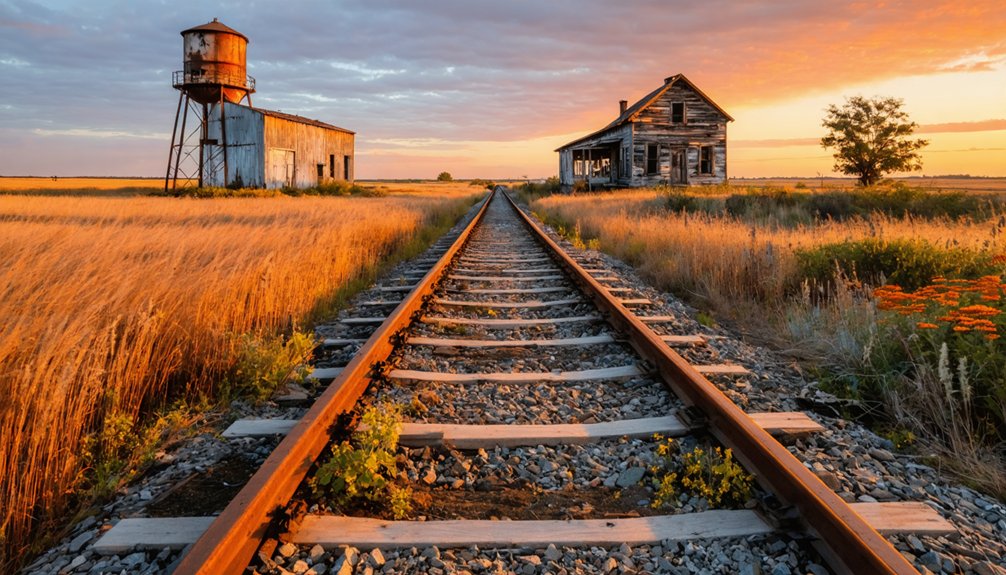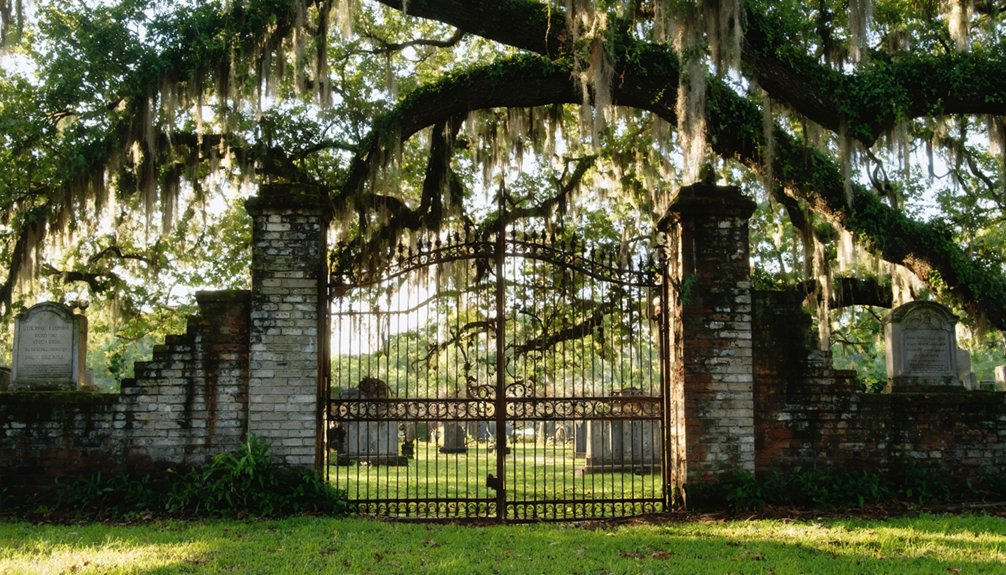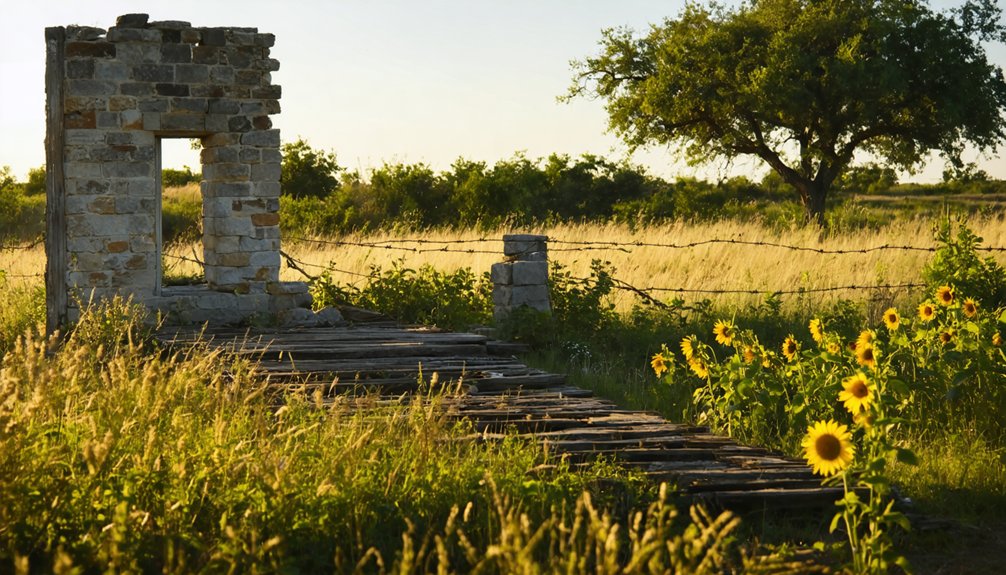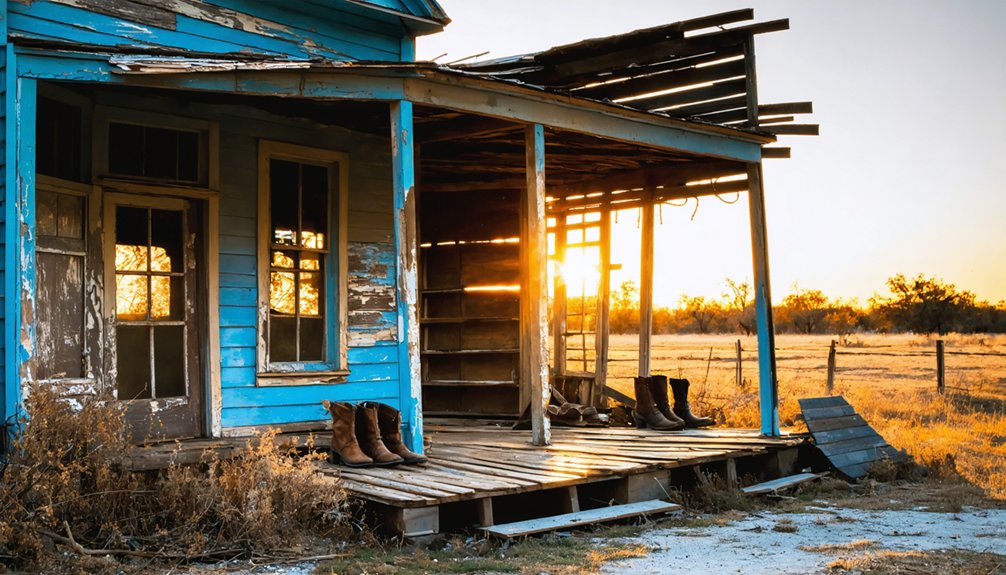You’ll find Boonville’s remains at the site of Brazos County’s first seat, established in 1841 along El Camino Real between the Brazos and Navasota Rivers. The town thrived until 1866 when the railroad bypassed it for nearby Bryan. Today, you can explore Boonville Heritage Park and the historic cemetery where notable pioneers like Harvey Mitchell rest. This ghost town’s preserved landmarks reveal fascinating chapters of Texas frontier life.
Key Takeaways
- Boonville was Brazos County’s first seat in 1841 but declined after losing its status to Bryan in 1866.
- The town’s downfall began when the Houston and Texas Central Railway bypassed it, shifting economic activity elsewhere.
- Boonville Cemetery remains the primary physical remnant, containing graves of early pioneers and the “Father of Brazos County.”
- The Missouri Pacific’s abandonment of Boonville’s branch line in 1935 marked the final chapter of the town’s decline.
- Boonville Heritage Park now preserves the ghost town’s history through historical markers and educational programs for visitors.
The Frontier Roots of Boonville
When Europeans first ventured into what would become Boonville in the late 1600s, they established El Camino Real along the northern edge of present-day Brazos County, marking the region’s earliest colonial influence.
You’ll find Boonville’s strategic position between the Brazos and Navasota Rivers made it ideal for settlement, trade, and agricultural development.
Founded in 1841 as Brazos County’s first seat, Boonville emerged during a period of increasing Anglo settlement, transforming from untamed wilderness into an essential frontier hub.
Boonville’s rise from wilderness to vital frontier center reflected the broader story of Texas settlement and territorial expansion.
While settlers faced frontier challenges, including Comanche raids, they persevered by building robust infrastructure like the formidable county jail with 32-inch-thick oak walls. Much like the early Texas forts, the settlement required federal protection against hostile Indian tribes.
The town became central to the region’s farming and ranching community, marking a significant shift from loosely organized frontier lands to a structured settlement.
The community thrived for twenty-five successful years until the arrival of the Houston and Central Texas Railway prompted residents to relocate to Bryan.
A Town Named for the Boone Legacy
Although many American towns bear the Boone name, Boonville, Texas stands as a tribute to one of America’s most influential pioneer families. The town’s naming reflects the enduring impact of the Boone legacy, which began when George Boone III and Mary Maugridge first arrived in America from Devonshire in 1717.
You’ll find the spirit of frontier resilience embedded in Boonville’s ghost town origins, echoing the practical character that defined the Boone family across generations. Their pioneering spirit was documented through early Boone manuscripts, meticulously preserving their remarkable family history. The family’s dedication to record-keeping was exemplified by James Boone, whose beautiful handwriting helped preserve crucial genealogical information in 1788.
As Boone descendants spread throughout America, settling in diverse regions from West Virginia to Texas, they carried with them a pioneer heritage that communities sought to honor. This heritage, preserved through extensive family documentation and the efforts of the Boone Family Association, continues to resonate in places like Boonville, where the name itself celebrates America’s frontier past.
Rise as Brazos County’s First Seat
You’ll find Boonville’s 1841 establishment as Brazos County’s first seat marked a crucial moment in the region’s development, transforming the settlement into a essential government center.
In that same year, Judge R.E.B. Baylor presided over the first court session, launching the area’s formal justice system in what was then called Navasota County. The court proceedings were held at Joseph Ferguson’s home, establishing the foundation for local governance.
The town’s administrative significance grew with the construction of its log-cabin courthouse and the significantly secure county jail, featuring 32-inch thick oak walls and a specialized two-room design that included a trap-door accessible dungeon.
Government Center Establishment
In 1841, the Republic of Texas Congress established Boonville as Brazos County’s first seat of government, positioning it strategically near the confluence of the Brazos and Navasota Rivers. Named after Mordecai Boon, the settlement emerged on John Austin’s league after Hiram Hanover’s survey.
The town’s government origins began with a simple log cabin courthouse, reportedly constructed in just one day. Today, researchers can explore records from this period through genealogy resources at the Carnegie History Center.
As the civic structure developed, pioneers like Harvey Mitchell shaped the community’s foundation. You’ll find his influence throughout early Boonville, where he served multiple roles including justice of the peace, minister, and surveyor.
The settlement quickly became the hub for essential government functions, supporting land surveying, record keeping, and the emerging agricultural economy that would define Brazos County’s early years. The first census of the area in 1850 recorded a population of 466 White settlers establishing themselves in the region.
Justice System Development
The jail’s impressive 32-inch-thick oak timber walls and unique two-room vertical design made escapes nearly impossible.
You’ll appreciate how the judicial evolution paralleled the area’s growth, with courts handling everything from land disputes to debt collection.
As a stagecoach stopover in the 1840s, Boonville developed critical transportation infrastructure that supported its administrative functions.
The town’s role as a government hub lasted until 1866, managing critical administrative functions like record keeping and tax collection during Brazos County’s formative years.
Life in Early Boonville Settlement
Life during Boonville’s early settlement revolved around a close-knit community of pioneers, farmers, and civic leaders who established Texas’s first Brazos County seat in the 1840s.
The pioneer lifestyle centered on agriculture, trade, and crucial services like blacksmithing, while community governance thrived under multi-talented leaders like Harvey Mitchell, who served as both minister and justice of the peace.
Named after Mordecai Boon, the community represented a strong connection to America’s frontier heritage.
The town’s population grew steadily after families successfully petitioned for a post office in the early 1870s.
You’ll find the settlement’s spirit of independence reflected in:
- A self-sufficient economy built on local stores, hotels, and stagecoach connections
- Active religious and social gatherings that strengthened community bonds
- Educational facilities and civic spaces that fostered learning and democracy
The town’s strategic location and diverse mix of tradespeople helped maintain Boonville’s liveliness until railroad development shifted the region’s dynamics in the 1860s.
The Railroad’s Impact on Town Destiny

While Boonville initially thrived as a bustling river port and agricultural center, its destiny changed dramatically with the arrival of competing railroad lines in the late 1800s.
The Missouri Pacific Railroad operated a crucial branch line south to Versailles, while the Missouri, Kansas & Texas Railway reached town in 1873, completing its river bridge the following year.
Yet this railroad competition ultimately led to Boonville’s decline. When the Houston and Texas Central Railway extended to Bryan in 1866, commercial activity began shifting away.
Despite early benefits from being a transportation junction, economic shifts favored other towns with better rail connections.
By 1935, Missouri Pacific abandoned its Boonville branch line, and the final train departed in April 1936.
Today, you’ll find remnants of this era preserved in the 1912 MKT station and Heritage Park.
Notable Residents and Community Leaders
You’ll find Harvey Mitchell’s multifaceted leadership as blacksmith, hotel owner, justice of the peace, and minister earned him recognition as the “Father of Brazos County.”
The town’s namesake, Mordecai Boon, Sr., nephew of renowned pioneer Daniel Boone, represents the settlement’s connection to America’s westward expansion legacy.
These early community pioneers established Boonville’s foundations through civic engagement, commercial enterprise, and religious leadership that shaped the town’s brief but significant role as the county seat.
Harvey Mitchell’s Civic Leadership
A pioneer of civic leadership, Harvey Mitchell arrived in Texas from Tennessee in 1839 and quickly established himself as a cornerstone of Boonville’s development.
Mitchell’s contributions shaped the foundation of Brazos County through his unwavering civic engagement, serving in multiple roles from county clerk to chief justice between 1842-1853.
You’ll find his impact reflected in these enduring achievements:
- Established the county’s first school in 1841, personally teaching local children
- Led construction of three courthouses, cementing Boonville’s role as a government center
- Created essential infrastructure through his businesses – a grocery store, gristmill, blacksmith shop, and inn
During the Civil War, Mitchell continued his public service as Confederate State tax assessor, demonstrating his lasting commitment to the community he helped build from the ground up.
Boon Family Historical Impact
Through his influential role as a founding father of Brazos County, Mordecai Boon Sr. left an indelible mark on early Texas history. As Daniel Boone’s nephew and a Texas Ranger, he was appointed by the Texas Congress in 1841 to establish the county seat, which became known as Boonville.
You’ll find his family’s lasting impact reflected in the town’s name and early development as an agricultural hub.
The Boon family’s community influence extended beyond civic leadership into the economic and social fabric of early Brazos County.
Today, you can explore their legacy at Boonville Heritage Park, where preserved structures and artifacts tell the story of frontier life.
The Boons’ connection to the famous Kentucky pioneer family exemplifies the spirit of westward expansion that shaped Texas during its formative years.
Early Community Pioneers
While Mordecai Boon Sr. established Boonville’s foundations, Harvey Mitchell emerged as the most influential figure in the town’s early development.
Through pioneer governance and community resilience, these leaders shaped Boonville’s identity as Brazos County’s first seat. Mitchell, known as the “Father of Brazos County,” exemplified the versatile nature of frontier leadership by serving multiple roles in the community.
Early pioneers’ lasting impact on Boonville’s development is evident through:
- The establishment of essential institutions, including the 1843 jail and local schools
- The creation of diverse economic ventures, from blacksmithing to hotels
- The preservation of their legacy at Boonville Heritage Park, featuring the Turner-Peters cabin and Masonic Lodge ruins
Today, their contributions live on through historical markers and place names, reminding you of Boonville’s pioneering spirit.
From Bustling Center to Ghost Town
During its heyday as the Brazos County seat from the 1840s to 1866, Boonville thrived as a bustling administrative and commercial center.
You’d find pioneer challenges overcome by prominent residents like Harvey Mitchell, who served multiple roles as blacksmith, store owner, justice of the peace, and minister.
The town’s economic shifts took a dramatic turn when the Houston and Texas Central Railway bypassed Boonville in favor of nearby Bryan.
Without rail access, Boonville quickly lost its position as county seat to Bryan in 1866. You can trace the town’s decline as businesses and residents migrated to the railway-connected hub, leaving Boonville increasingly isolated from essential trade routes.
The once-vibrant community gradually transformed into the ghost town you’ll find today, though its legacy lives on through Boonville Heritage Park and its historic cemetery.
Preserving History at Boonville Cemetery

You’ll find the graves of Brazos County’s earliest pioneers still standing at Boonville Cemetery, including that of Harvey Mitchell, known as “The Father of Brazos County.”
The Texas Historical Commission and local preservation groups maintain the site’s historical integrity through structure permits and cemetery conservation programs.
State-installed interpretive markers throughout the grounds tell the stories of Boonville’s founding families and their contributions to early Texas settlement.
Pioneer Graves Still Standing
The weathered headstones of Boonville Cemetery stand as silent sentinels to Brazos County’s pioneering past.
You’ll find pioneer memorials that span generations, telling stories of the area’s first settlers through carefully preserved family plots and military graves.
Though time and elements have taken their toll on many markers, local cemetery preservation efforts continue protecting these irreplaceable links to your heritage.
- Over 379 documented burials anchor your connection to the county’s founding families
- Confederate soldiers and veterans of multiple wars rest in these hallowed grounds
- Original east-west grave orientations reflect early Protestant burial traditions
Despite some unreadable markers, these pioneer graves serve as enduring monuments to the independent spirit that built Brazos County, offering you tangible connections to those who shaped this land.
Historic Markers Tell Tales
Standing proudly within Boonville Heritage Park, a newly dedicated state historical marker now chronicles the rich legacy of Boonville Cemetery.
While you won’t find ghost stories here, you’ll discover something far more compelling – the authentic tales of Brazos County’s pioneers etched in stone and bronze.
The marker, dedicated on May 13, 2024, honors 374 gravesites spanning nearly 170 years of local history, including the final resting place of Harvey Mitchell, “The Father of Brazos County.”
Historic preservation efforts shine through in every detail, from the marker’s unique base crafted with sun-dried bricks from the 1901 Ursuline Convent to the late Mary Ann Cusimano’s groundbreaking research that earned her the county’s first dedication on a marker base.
Heritage Park: A Living Memorial
Nestled in Bryan, Texas, Boonville Heritage Park spans 11.29 acres of historically significant land that preserves the last remnants of Brazos County’s original county seat.
A historic 11-acre park in Bryan, Texas preserves the original Brazos County seat through its cherished heritage landmarks.
You’ll discover the 1856 Turner-Peters Dogtrot Log Cabin, furnished with authentic 19th-century pieces, alongside replicas of the courthouse, smokehouse, and Masonic Lodge.
This heritage preservation site offers:
- A peaceful final resting place for pioneers like Harvey Mitchell at the historic cemetery
- Daily access from dawn to dusk for exploring Texas frontier history through interpretative panels
- Community engagement opportunities through docent-led tours and educational programs
You’re free to wander the tranquil grounds, capture springtime bluebonnets, and connect with Texas frontier legacy through statues honoring notable figures like Sam Houston and Hiram Hanover.
Lost Towns of the Texas Frontier

Among the countless settlements that once dotted Texas’ expansive frontier, Boonville stands as a poignant example of how railroad development shaped the destiny of early communities.
You’ll find its story echoed across the state, where towns flourished or faded based on their proximity to essential railroad routes.
Like many frontier settlements, Boonville’s decline wasn’t just about convenience – it was about survival.
When the Houston and Texas Central Railway bypassed the town in favor of Bryan, Boonville’s fate was sealed.
Today, ghost town tourism helps preserve these vanished communities’ stories, reminding you of an era when a single railroad decision could determine a town’s future.
Boonville’s transformation from county seat to abandoned settlement reflects a broader pattern in Texas history, where transportation access literally meant the difference between prosperity and extinction.
Frequently Asked Questions
What Was the Population of Boonville at Its Peak?
You’ll find Boonville’s peak population reached approximately 200 residents during its thriving years, when the town’s demographics and economy centered around its role as the county seat and community hub.
Were There Any Schools or Churches Established in Boonville?
Like tuning into an old-time radio, you’ll discover there was a school serving 200 students and religious activity led by Minister Harvey Mitchell, though no specific church buildings are documented in education history.
How Did Residents Make Their Living in Early Boonville?
You’d earn your living through farming techniques like growing crops and raising cattle, while local industries included blacksmithing, general stores, hotels, and civic positions serving the community.
What Happened to the Original Courthouse Building?
Like a deleted text message, the original courthouse vanished when it was demolished in 1954. You’ll find its architectural significance lives on through a replica at Boonville Heritage Park today.
Did Any Native American Tribes Live in the Boonville Area?
You’ll find the Karankawa and Akokisa tribes shaped the area’s tribal history, living along the Gulf Coast and nearby waterways. Their cultural impact remains through archaeological evidence and documented traditions.
References
- https://georgeslaughter.com/2018/07/19/texana-thursday-the-ghost-town-of-boonville/
- https://www.youtube.com/watch?v=T7hj1iweWi8
- https://kids.kiddle.co/Boonville
- https://www.allacrosstexas.com/texas-ghost-town.php?city=Boonville
- https://www.texasescapes.com/TexasGhostTowns/Boonville-Texas.htm
- https://en.wikipedia.org/wiki/Boonville
- https://www.brazosheritage.org/boonville-jail-historic-marker
- https://www.fbgtx.org/DocumentCenter/View/2519/The-Texas-Frontier-in-1850
- https://www.texasalmanac.com/articles/the-frontier-forts-of-texas
- https://www.thestoryoftexas.com/discover/campfire-stories/frontier-folk



